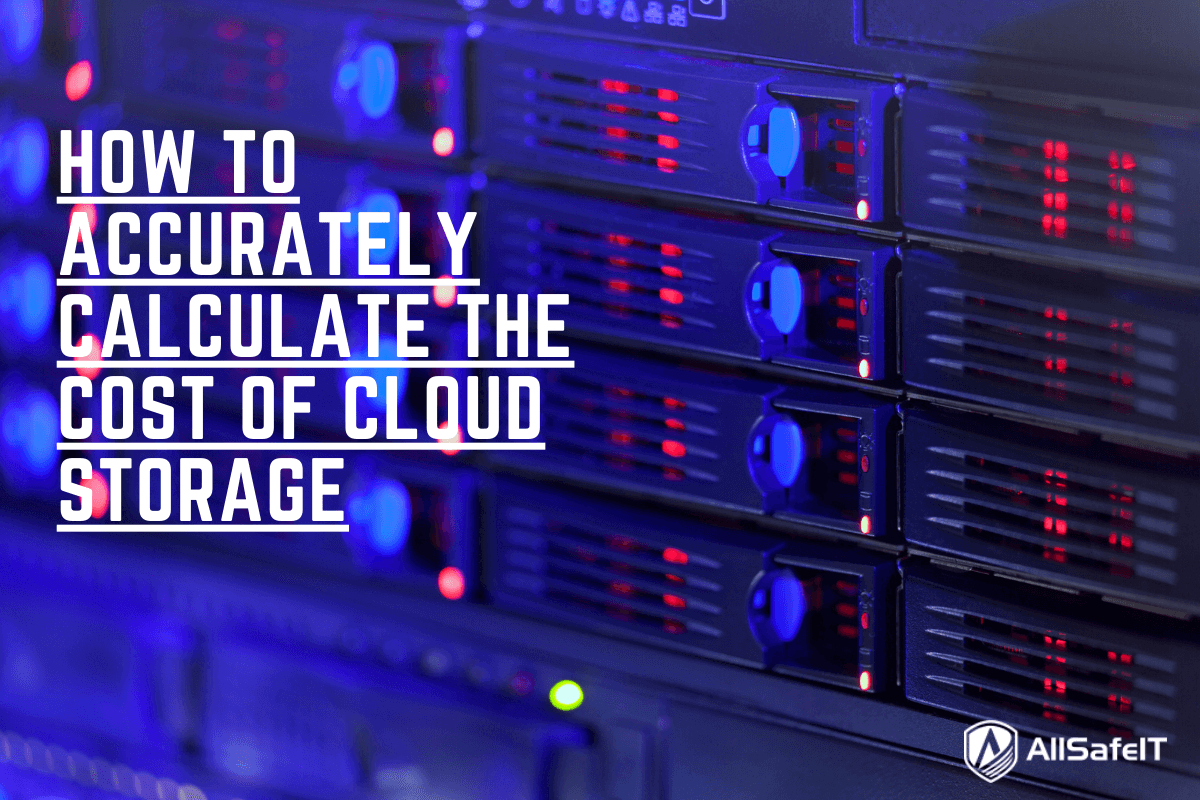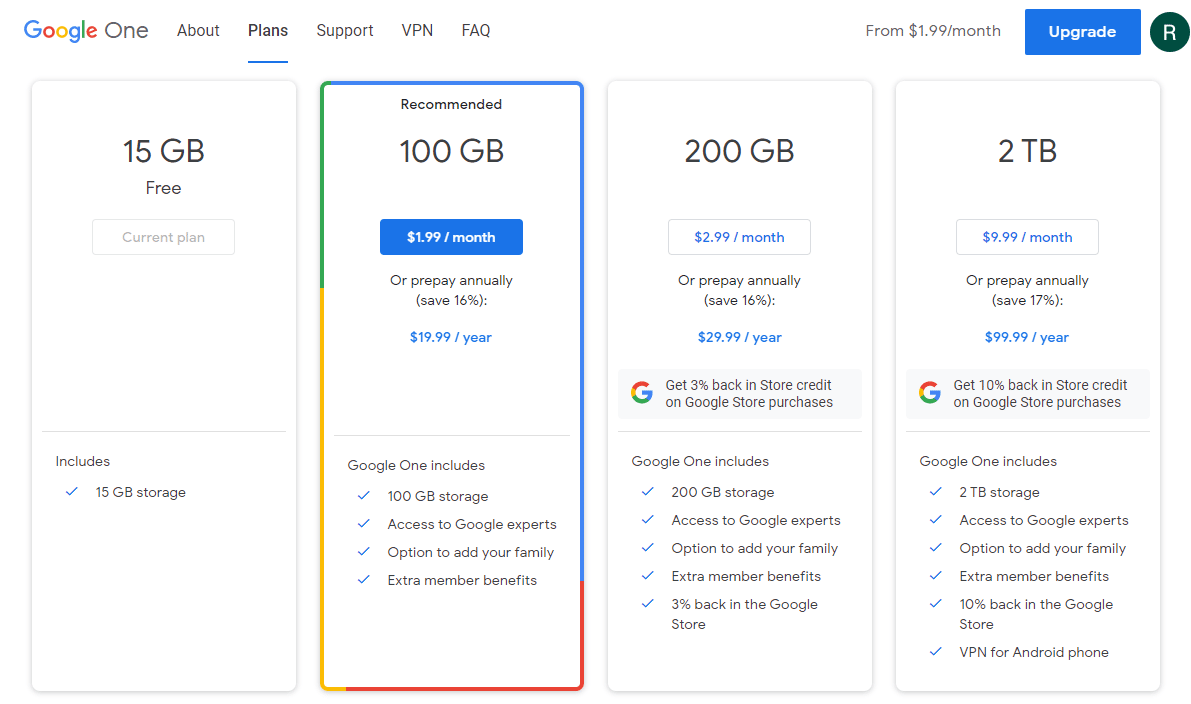
This is some text inside of a div block.
This is some text inside of a div block.
June 17, 2021
%20(1).webp)
CEO and co-founder
AllSafe IT is an IT services, consulting, and support firm with a certified team of technology experts and a client base spanning a range of industries.

Many businesses are moving their data from on-premise (“on-prem”) servers to the cloud, and with good reason. Migrating your business to the cloud offers many benefits such as increased cybersecurity, “work from anywhere” mobility, high availability, and reliability. But cloud storage pricing can get a bit tricky. We will break down some of the biggest cost factors to help give you an idea of what your cloud storage costs will be.

Pricing for personal cloud storage, such as Google One, Dropbox or OneDrive cloud storage pricing is very simple. You can easily look up “Google cloud storage pricing” or “Dropbox cloud storage pricing” and know exactly how much you will pay every month. Typically, personal cloud storage is charged in tiers per gigabyte or terabyte, with considerable discounts if you opt to pay for an entire year up front.
Unfortunately, a business or enterprise cloud storage pricing comparison is much trickier to put together. While it is easy to find the average cost of cloud storage per TB, the truth is that the actual storage is only one of many dimensions that factor into finding the best cloud storage pricing.

When moving to the cloud, keep in mind that the way cloud storage pricing is calculated is very different from on premise. Having tons of extra hard drive space on an on prem server will not have much impact. However, in a cloud environment, you are charged for the exact storage capacity you signed up for whether you use it all or not. If you go over your designated storage capacity, you may have to pay hefty overage fees as well. Make sure to optimize your storage and resources so that you are only using (and being charged for) exactly what you needed.

Make sure you understand the different storage tiers and migrate your data accordingly. Use the HOT storage tier for data that you will need to frequently access on an instant basis. Hot storage is fast and easy to access, making it more expensive. For items that you don’t need to access as often, such as archives or backups, use the COLD storage tier. As the name implies, cold storage is slower, but is much less expensive. Data in cold storage can take anywhere from several minutes to several DAYS to retrieve.
Depending on the provider, the tiers may go by different names and have intermediary tiers in between. For example, with Azure cloud storage pricing, they offer Premium and Archive tiers as well as Hot and Cool. When looking at AWS cloud storage pricing, they even have a Glacier tier. But generally, there will be a spectrum from HOT (fast and expensive) to COLD (slow and cheap).
Evaluate what you will be storing and make sure you place it in the correct tier. For example, if you store items in hot storage but don’t ever need to access it, you will still need to pay the same price. Conversely, do not make the mistake of trying to save money by storing items in cold storage because it’s less expensive. If you end up accessing cold storage data more frequently, not only will you end up waiting longer to get it (costing you in productivity), but you may even be charged higher fees to access it (more on Operations Fees below). If you need cold storage files immediately, you will end up having to pay a premium to expedite it.
Another thing to consider when looking at cloud backup storage pricing is what type of redundancy you will need. To protect your data from hardware failures, network or power outages, or even natural disasters, cloud storage providers will store multiple copies of your data to create redundancy.

Depending on how critical your data is (or how easily it can be reconstructed), you can opt for locally Redundant Storage (LRS). This means that you will have multiple copies of your data, but they will all be stored in the same data center. This is typically the least expensive and will protect your data in the event of a hardware failure. However, since all the data is stored in the same physical building, it can be vulnerable if there is a disaster in the area.
Zone Redundant Storage (ZRS) will store multiple copies of your data across different data centers in the same region. This offers greater protection for your data, as even if a whole data center becomes unavailable, the data will still be accessible from a different data center.
Finally, there are options for Geo-Redundant Storage (GRS) and Geo Zone Redundant Storage (GZRS), which means that your data is replicated in data centers across multiple geographical regions. With copies of your data stored around the globe, this is the highest-availability option and the most expensive.
So now that you’ve figured out how often you will access your data and how much redundancy you will need, you will also need to predict what you will be doing with the data. Activities like write and read operations will have associated storage operations fees. These fees are charged per every 10,000 operations.

Typically, the “cooler” the storage tier, the higher the storage operations fees will be. Because they are meant to be accessed rarely, operations fees for cold storage items can be several times as much as their hot counterparts. So again, make sure you store your data in the correct hot/cold storage tiers so that you are not paying more for operations fees.

Most cloud storage services provide online pricing calculators that you can use to try to predict what your actual costs will be. As detailed above, you will need to do a bit of homework and plan ahead to be able to use them. Even then, keep in mind that these calculators will only give a general idea of you can expect. Online calculators are not used professionally in IT consulting or for creating a proper scope for cloud storage.
It is important to note that, while some factors such as the amount of storage are easy to predict and therefore easy to calculate, other factors such as operations and data transfer fees can be wildly variable. Because of this, don’t expect your cloud storage costs to be the same every month, although they may be in the same ballpark.
Unfortunately, calculating cloud storage cost is not as easy as a per-GB or per-TB flat monthly fee. However, as long as you have: 1) optimized your storage and resources, 2) utilize the correct storage tiers and redundancy zones, and 3) have a good handle on your volume of storage operations activities, you will be able to predict your cloud storage costs. Because of the sheer complexity, you may prefer to enlist an experienced Managed IT Services provider to properly scope out your cloud storage strategy.
Are you overwhelmed by your company’s lack of IT infrastructure? AllSafe IT is an IT services, consulting, and IT support firm with a dedicated, certified team of technology experts with a client base spanning a wide range of industries. Our belief is that true partnerships are built from the results of actions – which is why we are firmly focused on making sure you experience uptime, all the time. It’s a simple promise, but it means a lot – and it’s the fulfilment of this promise that’s made us the partner of choice for our clients. Get in touch with our team today and let us bring your company to the next level, click here.